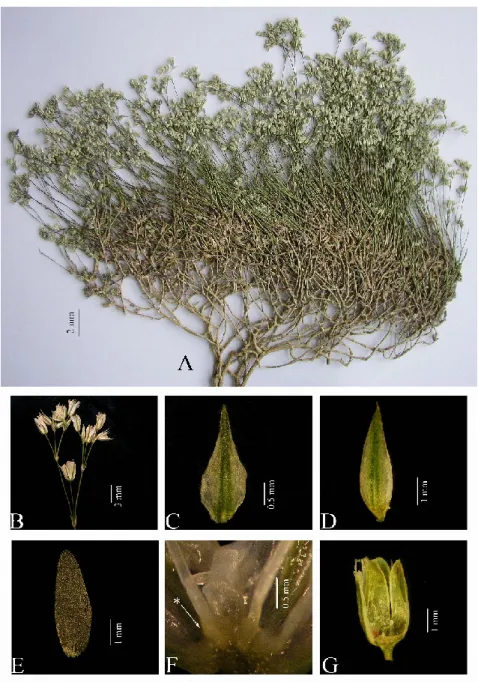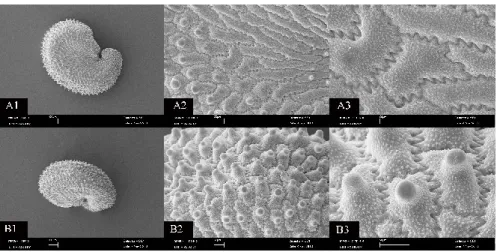ISSN 1303-6025
http://communications.science.ankara.edu.tr/index.php?series=C
© 2017 Ankara University Communications Faculty of Sciences University of Ankara Series C: Biology MINUARTIA SETACEA (CARYOPHYLLACEAE), A NEW
RECORD FOR TURKEY
Murat KOÇ1, Ergin HAMZAOĞLU2
1 Department of High School of Animal Production, Bozok University, 66200, Yozgat, TURKEY,
*E–mail: bozokmuratkoc@hotmail.com
2 Department of Elementary Education, Gazi Faculty of Education, Gazi University, 06500, Ankara, TURKEY,
E–mail: erginhamzaoglu@yahoo.com
(Received: February 21, 2017; Accepted: March 18, 2017) ABSTRACT
Minuartia setacea was given as a new record for Turkey. The specimens were collected from Kocaeli province. This new record was compared with the similar species in Turkey. The description, distribution and the figure of this new species were given. Seed structures were examined by scanning electron microscopy.
KEYWORDS: Minuartia, new record, taxonomy, Turkey. 1. INTRODUCTION
Caryophyllaceae family consist 80 genera and 2100 species mainly distributed Irano–Turanian and Mediterranean phytogeographic regions in the word. It has three subfamilies namely Alsinoideae Burnett, Caryophylloideae Arn. and Paronychioideae A.St. Minuartia L. genus takes place in subfam. Alsinoideae (DC.) Fenzl in the family Caryophyllaceae. Minuartia comprises ca. 120 species distributed mainly in the northern hemisphere, one species native in Brazil and Chile [1]. Minuartia includes 7 section and 74 taxa in Flora of Turkey [2, 3, 4]. As a result of recent studies, 2 taxa (M. dianthifolia (Boiss.) Hand.–Mazz. subsp. cataonica McNeill and M. dianthifolia (Boiss.) Hand.–Mazz. subsp. kurdica McNeill) were determined as synonym in this genus. Also two species (M. elmalia (Aytaç) Aytaç, Parolly & Ö.Eren, M.
& Ö.Eren) and one hybrid (Minuartia × antalyensis Parolly & Ö.Eren) have been added to this genus [5, 6, 7, 8]. As a result; the total number of taxa in this genus has been increased to 76 in Turkey [2, 3, 9].
Authors collected some Minuartia specimens from Ballıkayalar valley (Kocaeli) during the project (A.F.F.F./2009–05 and 113Z260), supported by Bozok University and TÜBİTAK to revise Turkey sect. Minuartia taxa (Caryophyllaceae). These specimens were compared with related species or photographs in the herbaria of G–Boiss., ANK, GAZI, ISTE, HUB, ISTF, EGE, Bozok University Herb., and with records in the literature [2, 3, 10, 11, 12, 13, 14, 15, 16]. The studies showed that these specimens are representatives of a species new record for Turkey.
2. MATERIAL & METHOD
The specimens upon which this study is based were collected from Kocaeli province of Turkey. The collected specimens were first compared with the similar species from Flora of Turkey and then Flora of the U.S.S.R., Flora Europaea and Flora Iranica in order to identify them [10, 13, 14, 15, 16]. Pictures were taken with an OLYMPUS SZX–16 Stereomicroscop, DP 72 digital camera and seed surface images were taken by Quanta Feg 450 scanning electron microscope (SEM) at Bozok University Research and Application Center. The vegetative parts were measured with a ruler with 0.5 mm accuracy and the floral characteristics were studied using an ocular micrometer. The collected specimens are deposited in the herbarum Bozok Universities.
3. RESULT & DISCUSSION
Minuartia setacea (Thuill.) Hayek subsp. setacea var. setacea, [Fl. Steier-
mark 1: 271 (1911)] (Figure 1, 2 and 3).
≡ Arenaria setacea Thuill., Fl. Paris, ed. 2, 220 (1779); Alsine setacea (Thuill.) Mert. & W.D.J.Koch, Deutschl. Fl. 3, 286 (1831); Sabulina setacea (Thuill.) Rchb., Fl. Germ. Excurs.: 786 (1832).
Type: France, near Paris, a fontainebleau, rocher du Cuvier, Thuiller s.n. (G, G00226887, photo!; isotypes: G, G00226875, foto!; G, G00226888, foto!).
Loosely caespitose perrenial herb. Stem erect or ascending, 10–20 cm, puberulent below glabrous above, loosely branched, base 0.5–0.8 mm diameter. Leaves linear–lanceolate, 5–12 × 0.6–1.1 mm, glabrous, 3–nerved at the base, greenish; apex acute to acuminate; margin memraneous at the base and ciliate; leaf sheath membraneous, 0.1–0.2 mm, glabrous or puberulent; leaf axillary fascicles open at flowering time. Bracts linear–lanceolate, 3–8 × 1–1.8 mm, glabrous, obscurely 3–nerved, middle nerved white; apex acute to acuminate; margin membranaceous, glabrous. Pedicels 2–7 mm, erect, glabrous. Inflorescence lax clusters, glabrous; flowers pedicellate, per cyme 3–8 flowered. Sepals ovate or ovate–lanceolate, 3–4.5 × 1–1.5 mm, obscurely 1 middle and occasionally 2 lateral nerved, glabrous; apex acute to acuminate; margin membraneous and glabrous, membrane 0.1–0.2 mm wide. Petals ovate to eliptic, 3–5 × 1–1.3 mm, 1.3 times as long as sepals, white; apex acute; cuneate at the base. Stamens 10; flaments 1–4 mm; staminal glands at the base of outer filaments, definite, 5–numerous, bipartite, white to orange. Styles 1– 2 mm. Capsule ovoid, 3–4.5 × 1–1.5 mm, 3–6 seeded, as long as sepals. Fl.
5–7, 930 m, rocky and stony places.
Seed micromorphology: Seeds reniform; 0.8–1 × 0.6–0.9 mm; brownish; lateral and dorsal surfaces tuberculate, tubercles papillate; cells oblong– eliptic, irregular; anticlinal cell walls uncertain V–undulat; periclinal cell walls conveks, wrinkled.
Specimens examined: Turkey – A2 Kocaeli: Gebze, Ballıkayalar valley, 40°50'N–029°30'E, 930 m, rocky and stony places, 24.7.2014, Koç 2354 &
Figure 1. Minuartia setacea subsp. setacea var. setacea (Koç 2354). A– habit, B– cyme, C– bract, D– sepal, E– petal, F– (*) staminal gland, G– capsule.
Figure 2. SEM photographs of the seed coat. Minuartia setacea (A‒ Ventral, B‒ Dorsal surface). (Scale bars: A1 and B1‒ 500 μm; A2 and B2‒ 100 μm; A3 and B3‒ 40 μm).
Figure 3. Distribution of Minuartia setacea (■) in Turkey.
were first compared with the related species in Flora of Turkey. According to this comparison, the specimens has some similarities with Minuartia
anatolica (Boiss.) Woron. var. anatolica but differ from it with apparent
glabrous leaves and inflorescence (Davis et al., 1988). So the specimens collected were compared with the flora of the neighboring countries which showed that the morphological characteristics of the species were identical with those of Minuartia setacea species. This reveals the fact that the species
Minuartia setacea which is known to be distributed in Europe and Russia
regions is also present in Turkish flora [13, 15].
Acknowledgements: We wish to thank TÜBİTAK (Project number: KBAG– 113Z260) and Bozok University (Project No: AFFF–2009–5) for financial support.
REFERENCES
[1] V. Bittrich, Caryophyllaceae. The families and genera of vascular plants, Magnoliid, Hamamelid, and Caryophyllid families vol. 2. Edited by K. Kubitzki, J. Rohwer and V. Bittrich. Germany. Springer. Pp: (1993) 206-236.
[2] J. McNeill, Minuartia L. Flora of Turkey and the East Aegean Islands, vol. 2. Edited by P.H. Davis. Edinburgh. Edinburgh University Press. Pp: (1967) 38-67.
[3] P.H. Davis, R.R. Mill and K. Tan, Minuartia L. Flora of Turkey and the East Aegean Islands. Edited by P.H. Davis, R.R. Mill and K. Tan, vol. 10 (Suppl. 1). Edinburgh. Edinburgh University Press. Pp: (1988) 67-69.
[4] K. Tan and M. Vural, Minuartia L. Flora of Turkey and the East Aegean Islands, vol. 11 (Suppl. 2). Edited by A. Güner, N. Özhatay, T. Ekim and K.H.C. Başer. Edinburg. Edinburgh University Press. Pp: (2000) 156-157.
[5] Z. Aytaç and H. Duman, Six new taxa (Caryophyllaceae) from Turkey. Annales Botanici Fennici 41 (2004) 213-221.
[6] Ö. Eren, M. Gökçeoğlu and G. Parroly, The flora and vegetation of bakırlı dağı (Western Taurus Mts, Turkey), inculuding annotations on critical taxa of the taurus range. Willdenowia 34 (2004) 463-503. [7] G. Parolly and Ö. Eren, Contributions to the flora of Turkey, 1.
Willdenowia 36 (2006) 823-844.
[8] M. Koç, A. Aksoy and E. Hamzaoğlu, A new species of Minuartia (Caryophyllaceae) from North-west Anatolia, Turkey. Turkish Journal of Botany 35 (2011) 337-341.
[9] N. Özhatay, Ş. Kültür and S. Aslan, Check-list of additional taxa to the supplement flora of Turkey IV. Turkish Journal of Botany 33 (2009) 191-226.
[10] J. McNeill, Taxonomic studies in the alsinoidae II. A revision of the species in the orient. Notes Royal Botanic Garden 24 (1963) 311-401. [11] K.H. Rechinger, Minuartia L. Flora of Lowland Iraq. Edited by K.H.
Rechinger. Austria. Weinheim. Pp: (1964) 233-234.
[12] M. Zohary, Minuartia L. Flora Palaestina, vol. 1. Edited by M. Zohary. Jerusalem. Israel Acedemy of Sciences and Humanities. Pp: (1966) 113-117.
[13] G. Halliday, Minuartia L. Flora Europaea, vol. 1. Edited by T.G. Tutin, V.H. Heywood, N.A. Burges, D.H. Valentine, S.M. Walters and D.A. Webb. Cambridge. Cambridge University Press. Pp: (1976) 152-160. [14] K.H. Rechinger, Minuartia L. Flora Iranica, (Caryophyllaceae II).
Edited by K.H. Rechinger. Austria. Akademische Druck-u Verlagsanstalt. Pp: (1988) 28-53.
[15] B.K. Shishkin, Minuartia L. Flora of the U.S.R.R. vol. 6. Edited by B.K. Shishkin. Moskva-Leningrad. Bishen Singh Mahendra Pal Singh and Koeltz Scientific Books (English version). Pp: (1995) 370-397. [16] V. Bojňanský and A. Fargašová, Atlas of seeds and fruits of Central
and East-European Flora: The Carpathian Mountains Region. Netherlands. Springer. Pp: (2007) 47-91.

